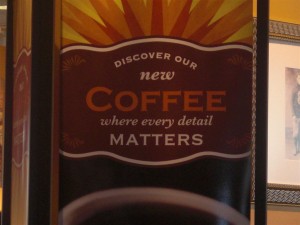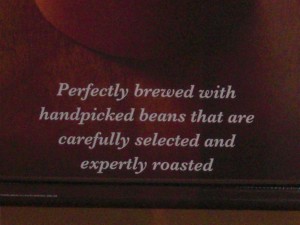Way back in December Sadie McC. sent in this Canadian ad for Tetley Red Tea, a variety that apparently originated in southern Africa:
We get several of the standard signifiers of “Africa”: tribal music with drums, elephants, and huts with thatched roofs (rooves? What’s the spelling consensus these days?). Both what mostly struck Sadie and I is our feeling that if we were marketing a food product, probably we would go with not choosing imagery that made the product look an awful lot like blood. My usual argument to students is that things in ads are not accidental; millions are spent on ad campaigns, and they are scrutinized, focus-grouped, and every detail is poured over by many individuals, all to add to the overall design. But in this case, I’m going to assume that somehow nobody noticed that the commercial kinda makes it look like wisps of blood creating scenes of Africa.
Anyway, I was looking around online for information about tea cultivation in Africa and found this short video about tea production in Kenya, including images of workers harvesting the tea:
[youtube]https://www.youtube.com/watch?v=zyP-l6eP_sE[/youtube]
It might be a good video to show if you’re talking about globalization and agricultural labor, to get students thinking about how our food gets to us and who is doing the often non-mechanized, back-breaking labor required for us to have such a wide variety of foods available year-round. In the video, the men don’t look obviously miserable, but my guess is that picking leaves with your bare hands for hours at a time, while carrying bags of leaves on your back, is pretty unpleasant, physically demanding work that probably isn’t highly paid. And I could be wrong, but I’m betting workers don’t wear protective gear to keep them from coming into contact with chemicals when the crop has been sprayed with fertilizers, pesticides, herbicides, or whatever else they might spray on the fields.
Apparently, due to the perceived healthiness of green teas, imports to the U.S. were up 7% in 2008, to about 257 million pounds. I was surprised, however, to learn that we’re only the 7th biggest consumer of tea. Having grown up in Oklahoma, where sweet tea was ubiquitous and nearly mandatory, and is the only beverage served at my family’s get-togethers, I sort of have this idea that everyone drinks iced tea, all the time, and expected us to rank higher.
Random tea-and-Gwen-related story: I was a waitress in Wisconsin for a while, and one time a woman ordered “regular” tea. I brought her a glass of unsweetened tea in a glass. She stared at it and said “I just wanted plain tea.” I assured her I had brought the unsweetened kind, but she insisted again that she just wanted “normal” tea. I was pretty confused at this point and explained again it wasn’t the raspberry-flavored tea and it wasn’t sweetened, it was just plain. She then very slowly, in that extra-loud and enunciated voice people use to talk to people they think are either not too bright or maybe don’t speak their language very well, that she wanted “the kind that comes hot, in a teapot,” making exaggerated gestures like she was pouring tea into a cup. I called my mom later and she was as befuddled as I was to think that anyone would mistake that kind of tea for normal tea.
And then I found out the Brits drink milk in tea.
UPDATE: Commenter Christine says,
…red tea is not just from southern Africa, but very specifically South Africa, with strong historical ties to colonialism in the area. Even the other name the tea is known by, rooibos, is an Afrikaans word; the Afrikaans language developed among Dutch settlers in South Africa. Cultivation of the plant began in the 1930s; commercial production came about around WWII; apartheid laws were enacted in 1948.
And reader Steve W. sent in two photos of some coffee he saw for sale at Panera Bread, where the package assures buyers that “every detail matters” and that the coffee is made from “handpicked beans that are carefully selected”:


As Steve points out, for most of us, when we see descriptions like “handpicked,” we usually don’t connect it to actual people doing actual work. It’s also interesting that the phrase “handpicked” is used to imply that the product is somehow special and carefully produced. But the video above shows handpicked tea, and I don’t think you can argue it was being carefully chosen (the workers, after all, need to pick as quickly as possible to increase their pay), but also you’ll see the phrase used in situations where most of the crop is harvested by hand, meaning that it doesn’t indicate any special production process at all.
Gwen Sharp is an associate professor of sociology at Nevada State College. You can follow her on Twitter at @gwensharpnv.
Comments 12
Cara — March 23, 2009
Hehe. Well, this most likely is a regional thing, but I'd be terribly confused if anyone assumed that iced tea of any kind was normal tea. Though both types are popular here, so I probably would have asked "do you mean hot tea, or iced tea?"
And are you talking about milk in hot tea or iced tea? Pretty much everyone I know who drinks hot tea (I personally hate tea of all varieties) drinks milk in it. And it's my understanding that hot tea, not iced tea, is the extremely popular type in Britain. But yeah, if that's a regional thing, I certainly wasn't aware of that, either!
catherine — March 23, 2009
Hot tea (plain tea, earl grey or orange pekoe) is almost always drank with milk in it. I find it so odd when I head to the US and have to ask for hot tea instead of the regular iced tea.
Martin — March 23, 2009
It took me a while to figure out what went wrong in the waitress story -- the possibility of you serving iced tea didn't even cross my mind. I'm in Sweden, and as far as I can tell, hot tea is ten times as popular and common here as iced tea. And yes, we often drink it with milk.
(I like iced tea, but come to think of it, I don't think I've *ever* seen anyone except me order or buy it).
Lyndsay — March 23, 2009
Since I've discovered the many kinds of loose teas there are I generally don't put milk in tea. I drink roibos, ceylon, mint, fruity teas and I will try others.
chuk — March 23, 2009
Up in Canada the American's I know really don't like how Iced tea is basically treated under the category of soft drinks. It comes in pop bottles, and is marketed similarly. It also doesn't taste anything like tea. As a child I remember asking adults on several occasions why they called the stuff ice tea, because it clearly was not cold tea. I think I was well into my late teens before I realized that this pop like drink was a derivative of a drink served elsewhere in the world that was actually iced tea.
"Normal tea," to me, is generally orange pekoe, but sometimes green tea, and always hot.
(I grew up in Vancouver)
Vettekaas — March 23, 2009
hmmm I wasn't seeing blood.. more like steam.... creating exotic scenes of a mystical Africa that I certainly have never seen in my travels.
Christine — March 23, 2009
I do think it's interesting, and important to mention, that red tea is not just from southern Africa, but very specifically South Africa, with strong historical ties to colonialism in the area. Even the other name the tea is known by, rooibos, is an Afrikaans word; the Afrikaans language developed among Dutch settlers in South Africa. Cultivation of the plant began in the 1930s; commercial production came about around WWII; apartheid laws were enacted in 1948.
Lindsay — March 23, 2009
Wow. That's funny. I'm in Toronto, Ontario, Canada, and for me, "normal" tea is for sure hot orange pekoe. The kind of tea you drink in a glass is iced tea.
Also, thank you for pointing out that blood grossness. I've been driving my sister nuts for weeks by yelling "it's the river of bloooooood!" every time that commercial comes on TV.
Elena — March 24, 2009
Tea tied to colonialism and exploitation? Not the first time, by a long margin.
thewhatifgirl — March 25, 2009
I've been drinking rooibos for a long time and it doesn't look like blood to me, but like the tea itself, which is a very strong red color much like watered-down blood.
Interesting that you would say that, though, since I've always thought rooibos tasted very similar blood (as per my experiences losing teeth as a child).
PattiLain — March 26, 2009
Ha ha, as a South African, "normal" tea always means ceylon (sp?) tea, as opposed to rooibos. When it comes to hot drinks, you've got a choice of normal tea, rooibos and coffee. I didn't even know rooibos is becoming popular overseas, I always thought it was just a South African thing.
And here, iced tea is also treated like a soft drink. It comes in cans, or plastic bottles like juice.
Rooibos tasting like blood? I never would have made that connection. It doesn't have the same unhealthy caffeine and stuff, which makes it the tea that parents give to their kids, or the tea ill people drink, or people trying to be healthy.
Sandra — March 29, 2009
I am American, and I have to say I was pretty confused by the waitress story also. I had to read it several times before I realized the confusion was over hot versus cold tea. But maybe because I'm from the coasts and not the midwest?